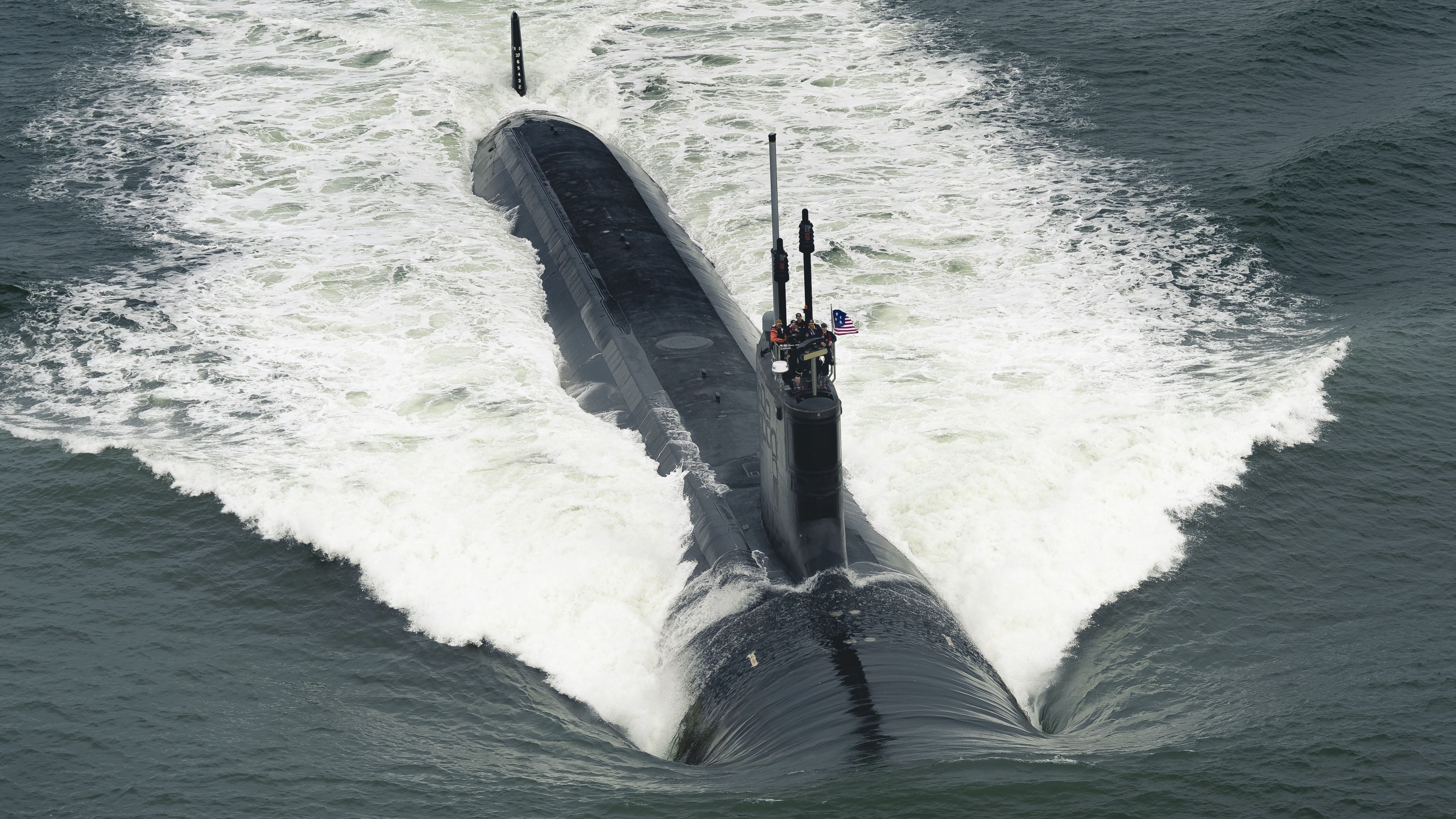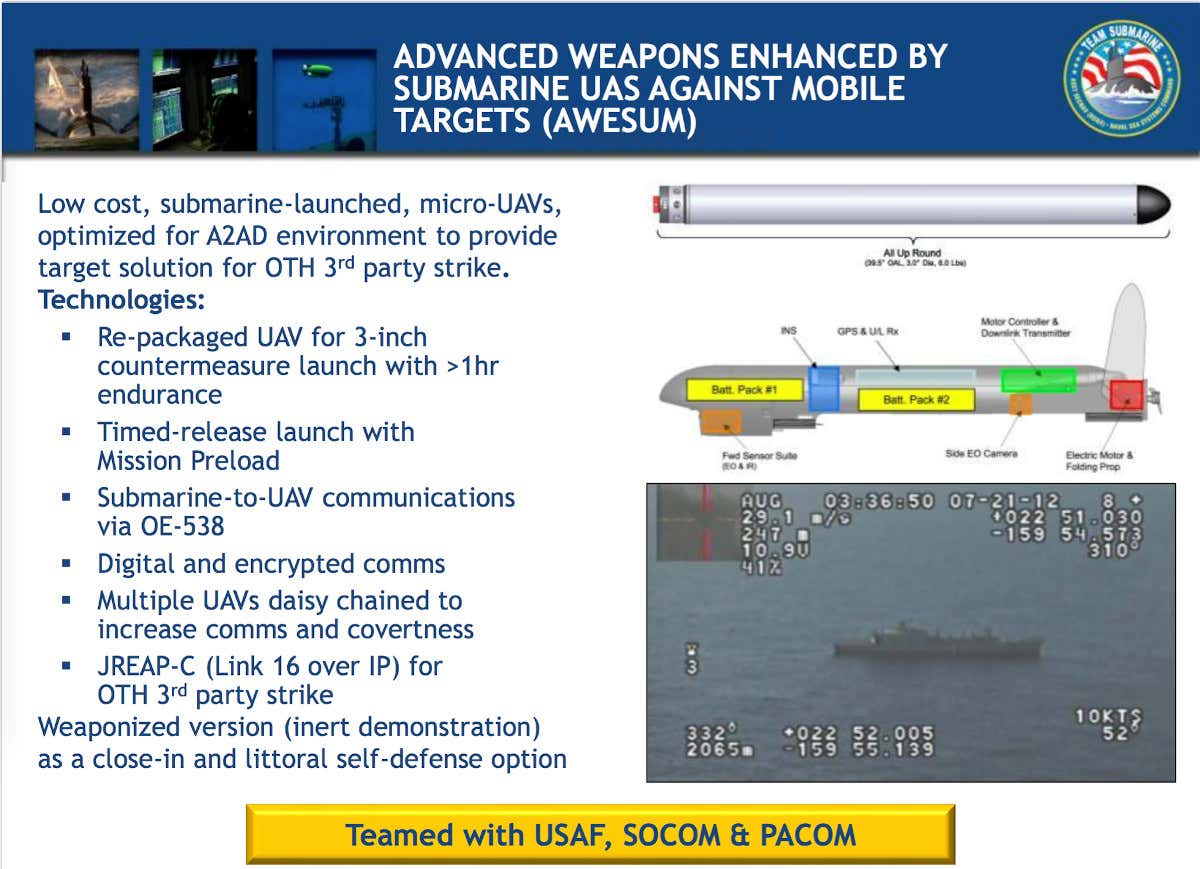The AeroVironment Blackwing drone is about to be procured in significant numbers by the U.S. Navy, providing its submarines with an organic unmanned aerial vehicle (UAV) capability that can be launched from below the waves. It’s the latest development in a field in which the Navy has been conducting test work for some time now, as you can read about in this past War Zone piece. In the meantime, it’s likely that the Navy has other similar capabilities already fielded, and perhaps even some examples of older Blackwings.
A request for proposal (RFP) today on the U.S. government’s contracting website beta.SAM.gov, revealed that the Naval Sea Systems Command (NAVSEA) plans to buy up to 120 Blackwing 10C UAVs from the California-based company. Although the Blackwing is derived from the Switchblade loitering munition, or “suicide drone,” but the latest RFP, however, mentions only unarmed drones.

The roughly four-pound Blackwing has an inertial/GPS autopilot system and a secure digital data link to maintain communications with the submarine. In order to fit inside a canister, the UAV has two pop-out wing sets with a span of 27 inches, and it’s powered by an electric motor-driven pusher propeller. The drone can be launched from both submerged submarines and from unmanned underwater vehicles (UUVs) and, while the RFP notice doesn’t specifically mention what they will be launched from, in the past Blackwings have been fired from submarines’ three-inch countermeasures tubes during demonstrations.
The Blackwing 10C variants will be equipped with miniaturized both electro-optical and infrared sensors in its nose and will be procured as part of the Submarine-Launched Unmanned Aerial System (SLUAS) program. It is unclear how the 10C version differs from previous Blackwings, but it has at least something in common with the same company’s Switchblade 10C that features an upgraded digital data link and allows concurrent operation of multiple drone systems in the same area.
The notice confirms that, as of today, the Blackwing 10C has been approved for integration in the SLUAS program under a Tactical Temporary Installations (TEMPALT) effort. Actual drones could be delivered from August this year, according to the Navy, with related contracts scheduled to run for a two-year period beginning May 2021.
“AeroVironment is the only known responsible source that possesses the facilities, tooling, equipment, manufacturing expertise, and technical expertise to provide the required Blackwing 10C UAVs within the government’s required delivery and ordering period,” the RFP stated.
Back in 2013, the Navy announced it had successfully demonstrated the ability to launch an encapsulated unmanned aircraft via a submarine’s torpedo tube and that it had been actively testing the Blackwing from standard countermeasures launchers.

According to the service, the new drones “will be used on various Navy submarine platforms during the SLUAS Middle Tier Acquisition program execution,” although there was no further detail provided about how they will be used. However, “Middle Tier” suggests there are multiple layers of SLUAS development, likely involving different UAVs and capabilities. This ties in with a statement last November, Rear Admiral Dave Goggins, the Navy’s Program Executive Officer for Submarines, who said that 21 SLUASs had been employed in demonstrations, though it’s not clear how many individual types the Navy has actually experimented with.
NAVSEA first posted a contracting notice for the SLUAS program online last October. At that point, it was only seeking proposals for potential SLUAS designs and didn’t yet have firm plans to buy any such drones.
“The Navy requires the capability of a SLUAS with a 3-inch diameter form-factor to provide enhanced sensor, communication, and cyber-security capabilities,” last year’s contracting notice read. “The integrated system should be capable of launch from the US submarine fleet’s 3-inch Signal System Ejector (SSE) equipment.”
“Threshold performance of the air vehicle should include electro-optic capability with reliable target solution analysis,” it continued. “The vehicle should remain airborne for at least one hour, operate at ranges out to the line-of-sight radio horizon, and use a variable bandwidth encrypted datalink with at least 256-bit encryption strength.”
In the past, The War Zone
has examined how small-size submarine-launched drones could be used in combat, including providing a discreet surveillance asset that could be hard for an enemy to detect, let alone the submarine from which it was launched. This kind of beyond-line-of-sight intelligence-gathering capability could be used by the submarine to help target surface vessels, for example, before launching a torpedo.
“Consider a submarine-deployed unmanned aircraft as a flying periscope able to dramatically extend our submarines’ organic sensor range, provide target-quality sensor data back to the submarine, or to a joint force capability, and enable Harpoon and Maritime Strike Tomahawk missile engagements,” Navy Rear Admiral Blake Converse, Commander, Submarine Force, U.S. Pacific Fleet, said in an online presentation last year.
Beyond the “flying periscope” capability offered by a sensor-equipped drone like the Blackwing, there’s also very real potential for submarine-launched drones to operate together as a swarm. Not only could such tactics cover a much wider area in a surveillance capacity, but they could potentially also undertake a range of other missions, too, acting as decoys, carrying payloads including electronic warfare jammers and even potentially small munitions. An armed UAV launched from a submarine in this way could also be used to defend against close-in threats, such as small boats, and this littoral self-defense option is something the Navy has previous considered in relation to Blackwing.
Operating more than one drone simultaneously also offers the possibility of extending line-of-sight connectivity as communications relays, not only between the submarine and Blackwing but also as a gateway for UUVs, in what the company describes as “mother-daughter” operations.
In addition, communications relay could be especially important during special operations missions, for which submarines are increasingly prepared. It is easy to imagine how a UAV, or fleet of drones, could work in support of submarines such as the quartet of converted Ohio class nuclear-powered guided-missile submarines, or SSGNs, each of which can deliver dozens of special operations frogmen into contested territory. In such a scenario, the drones could scout ahead of the troops, providing (armed) overwatch and monitoring the unfolding operation while maintaining a link between the operatives and the submarine.

Added flexibility comes from the fact that the Blackwing drone doesn’t have to start operating as soon as it’s fired from its launcher. As AeroVironment’s Chief Marketing Officer, Steve Gitlin, told The War Zone in an interview last year, the drone “doesn’t have to launch right away. It could be sent to the surface and set to launch at some later time when no submarine’s in the area.”
“It can be programmed to conduct a mission and because it incorporates the digital data link that AeroVironment developed for all of our tactical unmanned aircraft systems and Switchblade, not only can it collect information and generate situational awareness, but it can also act as a pop-up mesh network in the middle of the ocean to connect surface vessels to undersea vessels to manned vessels to unmanned vessels and create basically a pop-up mesh network in the ocean,” Gitlin added.
With a multitude of possible payloads, the opportunities are boundless. What is clear is that the Navy is now committed to the Blackwing, and to submarine-launched UAVs in general, and we are only likely to see more developments in this intriguing field in the months and years to come.
Contact the author: thomas@thedrive.com
